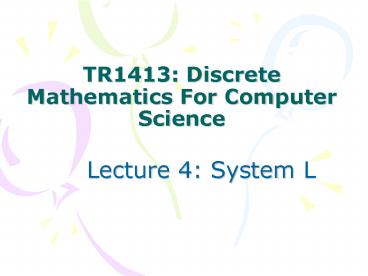TR1413: Discrete Mathematics For Computer Science PowerPoint PPT Presentation
1 / 16
Title: TR1413: Discrete Mathematics For Computer Science
1
TR1413 Discrete Mathematics For Computer Science
- Lecture 4 System L
2
Introduction
- One of the famous propositional formal system was
developed by Lukasiewicz, known as System L.
3
Alphabets in System L
- Consists of
- The infinite set of propositional variables
p1,p2,,pn - The set of punctuation symbols ,,(,)
- The set of logical operators ?,?
4
wffs in System L
- A propositional statement P is a wff in System L
if it conforms to one of the following
conditions - P is a propositional variables or
- P is of the form (?Q) where Q is a wff or
- P is of the form (Q ? R) where Q and R are wffs.
5
Axioms in System L
- Three axioms
- L1 (U ? (V ? U))
- L2 ((U ? (V ? W)) ? ((U ? V) ? (U ? W)))
- L3 (((?U) ?(?V)) ? (V ? U))
- where U, V and W are wffs.
6
The Inference Rule of System L
- System L has only one rule of inference, known as
modus ponens (MP). - The rule
- If V and (V ? W) are wffs of L which are members
of a proof sequence the the wff W can be added to
the proof sequence.
7
Proof in System L
- A proof is defined to be a sequence of wffs of L
such that each wff is either - An instance of an axiom of L or
- Derivable from two earlier wffs in the sequence
using the rule MP. The two earlier wffs must be
of the form P and (P ? Q). - Every steps in a proof must be justified clearly.
8
Examples of proof in L
9
Deduction in System L
- A deduction from the set of wffs T in System L is
defined to be a sequence of wffs such that each
wff is either - An instance of one of the axioms of L, or
- One of the hypotheses, or
- Is derivable from two earlier wffs in the
sequence using the rule MP. - If such a sequence exists, the the sequence of
wffs leading to a given wff P is said to be a
deduction of P from T in L.
10
Examples of deduction in L
11
Derived Rules of deduction
- The Deduction Theorem
- The Inverse Deduction Theorem
- Hypothetical syllogism
12
The Deduction Theorem
- Can be stated as
- If T ? U ? V where U and V are wffs, and T is a
set of wffs, then T ? (U?V) - Meaning
- If V is deducible from a set of hypotheses which
include U, then U?V is deducible from the set
with U removed.
13
The Inverse Deduction Theorem
- Can be stated as
- If the deduction T ? (U?V) where U and V are
wffs, and T is a set of wffs, can be established,
then the result T ? U ? V holds.
14
Hypothetical Syllogism
- Can be stated as
- (U?V), (V?W)? (U?W)
15
Examples
16
Notation
- In the textbook, rules are written by using a
horizontal bar. - For example, Hypothetical Syllogism is written as
- (U?V), (V?W)
- (U?W)

